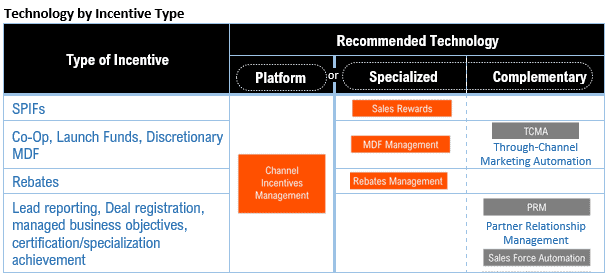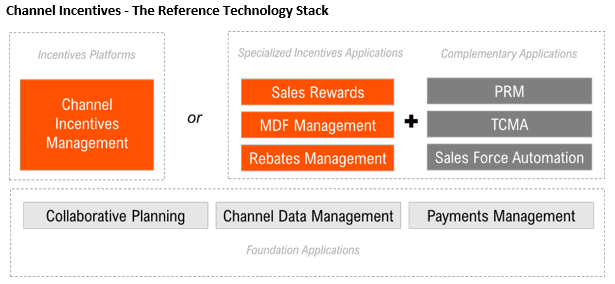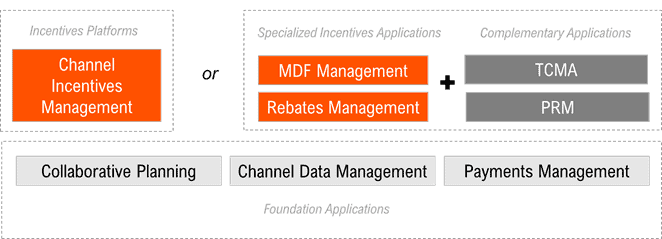
There is one advantage to having poor channel incentives technology: You can always blame it on the tools!
In my previous blog post, What Could Make Your Channel Partner Incentives More Successful?, I examined why many channel incentive programs don’t achieve their objectives. Based on analysis published by Forrester SiriusDecisions, it is very clear that having the right technology infrastructure to run your incentive programs is fundamental to success. This urges the question: What is the right technology?
To find out, we need to go on a journey.
First Stop: The Reference Incentives Technology Stack
Imagine you can create and run any kind of incentive program you can think of. Imagine you can manage every aspect of each program, every validation, every calculation and every partner interaction smoothly, without hiccups or delays. Imagine you can measure the performance of your incentives at any time and act immediately if necessary. Imagine that all of these possibilities can be realities using the right software.
That software represents what’s called the “reference technology stack” for incentives—a set of applications that, together, enable a company to create, run, support, measure and improve every conceivable type of incentive program, effectively and efficiently. Still sounds like a black box? Let’s lift the lid and define the list of applications.
We’ll start with functional applications. Channel incentives are a broad term and Forrester SiriusDecisions includes a wide variety of instruments under this umbrella. Each of these instruments (types of incentives) will have slightly different functional requirements. Market development funds (MDF) require workflows and prior approvals and proofs of execution. Sales performance incentive funds (SPIFs) use product catalogs for rewards and prizes. Rebates need powerful validation and calculation engines and analytics. Using Forrester SiriusDecisions’ definition of incentives, the table below provides e2open’s recommendations on which technologies best support the various incentive types.

In addition to the above technologies, you should consider three other foundational applications. First, channel data management technology provides high-quality data needed to evaluate the actual impact of incentives on sales metrics and partner performance. Secondly, collaborative channel planning technology provides the mechanism to ensure that investments across all incentives and partner activities are aligned and support corporate goals. Thirdly, payment solutions or outsourced payment services reliant on software tools help ensure all reimbursements to partners are prompt, auditable and executed with minimum operational cost.
Without these foundational technologies, any specialized incentives solution or platform will struggle to realize its full potential and deliver the benefits you are hoping for.
The diagram below brings all of these applications together and shows the reference technology stack required to support channel partner incentive programs, in its two variants – platform plus foundation applications or à la carte combination of specialized, complementary and foundation solutions.

Next Stop: The Required Incentives Technology Stack for You
The reference technology stack can help you identify the incentives technology stack that is optimal for your business as well as define a path to adopting that required stack.
You will first need to look at the type of incentives that you run currently, and the type of incentives that you anticipate offering in the future. If there are certain types of incentives that, for whatever reason, your organization will never offer, then you can remove from the reference stack the applications needed to support them. You will then end up with your required technology stack.
For example, SPIFs and deal registration are not on the radar for company A, which sells in a high-volume B2B2C environment. However, volume rebates, market development funding and rewards for reseller certification achievements are. Therefore, the required technology stack for company A is:

Last Stop: The Path to the Required Stack
To define the path to your required stack, you will need to do a gap analysis and establish what you already have and what you are missing compared to the required stack. In our example above, company A already has deployed rebates management through channel marketing automation and channel data management applications. The gap analysis for company A will look like this:

Once you know where the gaps are, you must decide whether you need a platform, or if a mix of specialized and complementary applications is the way to go. And for that, you will need to understand the trade-offs.
Incentives platforms provide more adaptability since they can grow and accommodate new incentive types as your company grows. Platforms can also support goals alignment among all incentive types out of the box, and this maximizes incentives impact. Let’s say, for example, that you offer MDF to stimulate the demand for product A, a well-thought-out SPIF to reward individual partner sales reps for selling product B, and a percentage rebate to reward the partner at a company level for achieving sales goals for product C. This combination can prove confusing for the partner. Should they focus on generating demand for product A? Will the salespeople pay attention, or will they try to push product B, which rewards them personally? Will the partner executives be interested in using MDF to generate demand for product A when the rebates they could get for product C go to their bottom line? When using independent applications, it is not always possible to see potential conflicts. A platform, on the other hand, exposes the conflicts and may even issue warnings about them.
However, incentive platforms are less mature than specialized and complementary incentive technologies, and therefore likely to have functional gaps. Also, adopting a platform tends to render existing investments in specialized incentives solutions redundant. If your old incentives applications are not up-to-par in their respective areas, or you manage most of your incentive processes on spreadsheets, then consider a platform.
By comparison, specialized and complementary incentives software applications tend to offer a great deal of flexibility in deployment, richer capabilities and can complement existing investments. The trade-off is that additional investments in specialized solutions will likely be needed for each new program type the company begins. Optimizing the impact across all programs may also become challenging unless you invest in integration among all solutions in your stack. If you only run one type of incentive ( for example you only offer MDF) or you already have a number of specialized and complementary solutions you are happy with, then flexibly selecting your preferred combination of applications may be more suitable for you.
Finally, it is worthwhile to look for a vendor who can offer the best of both, a channel management suite of integrated applications providing foundational, specialized and complementary capabilities. This would allow you to deploy your incentives stack one step at a time without worrying about integration or about how you can protect good past investments.
With its Channel applications suite, e2open can help you create the right technology stack for your current and future incentives programs.
To learn how to financially justify an investment in incentive infrastructure, look out for our upcoming eBook on the topic.
1 The Pulse: The State of Channel Partner Incentives 2020, Forrester Research, Inc., 2020
More in Channel Shaping
Launch Communication Plan: A Guide and Template for a Successful Channel Marketing Launch
You’re launching a new program or platform to increase partner engagement. You can’t wait to get […]







